Collectively, 103 trillion emails are sent worldwide every year … that's not a typo.
And 58% of people check their email before doing anything else online. It's no secret that email isn't dead despite the abundance of messaging apps and social media platforms sprouting up everywhere you look.
There's a reason 81% of businesses rely on email marketing for customer acquisition — the impressive return on investment (ROI).
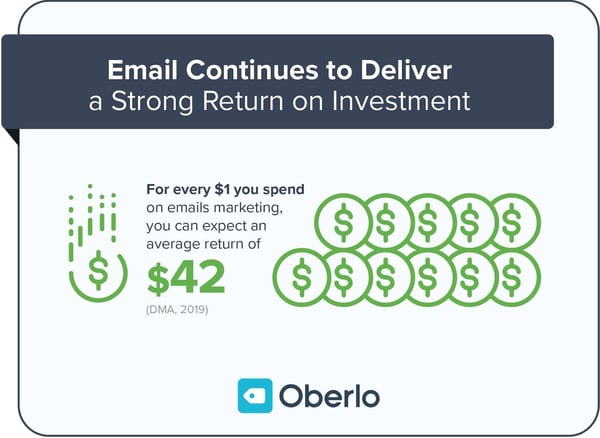
We all know it's important. Yet many marketers get lost in the trillions of emails floating through cyberspace.
While there's no such thing as a perfect email strategy, it's important to consider the thought process of users at each stage of the buyer's journey along the way. What kind of information are they looking for? Why should they trust you?
What's going to help them the most, right this second?
If you're not sure, don't worry. You're in the right place.
Keep reading to learn how to answer these questions and start delivering the right emails at the right time for your audience. By the end, you'll know what to offer, when to send your emails, and how to stand out in an endless sea of email oblivion.
What is an email funnel?
An email funnel is an automated campaign or series of emails that guides your audience from one stage of the buyer's journey to the next. Each email's job is to nudge your readers one step closer to the final action you want them to take.
There are four stages (or five depending on who you ask) in this funnel.
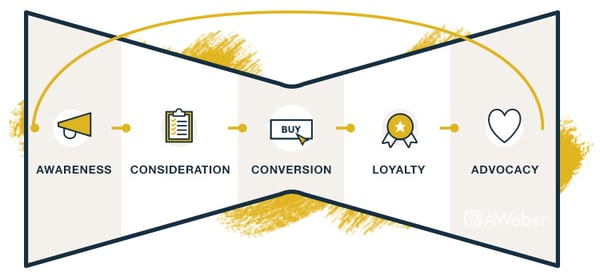
The types of content you create and send should differ from one stage to the next. This is because readers at different stages are interested in different types of information. In other words, not all stages are created equal.
So, let's start at the beginning.
Stage 1: Awareness
New subscribers enter the buyer's journey at the top. It's the largest portion of the journey because it includes a wide net of readers interested in what you have to say. As we move through the stages, the net becomes smaller and smaller.
For most, joining your list is the first time they're interacting with your brand.
So, they enter at the awareness stage. At this point, they're not ready to buy anything from you. New subscribers aren't interested in an inbox full of annoying and repetitive product promotion emails (you know the ones).
They want to know:
- What's in it for them
- Why they should stay on your list
- How you're going to help them
The average open rate in North America is 19.49%. But, welcome emails have an open rate closer to 50%. New subscribers expect to get a warm welcome, so this is your chance to show them why they made a smart decision in joining your list.
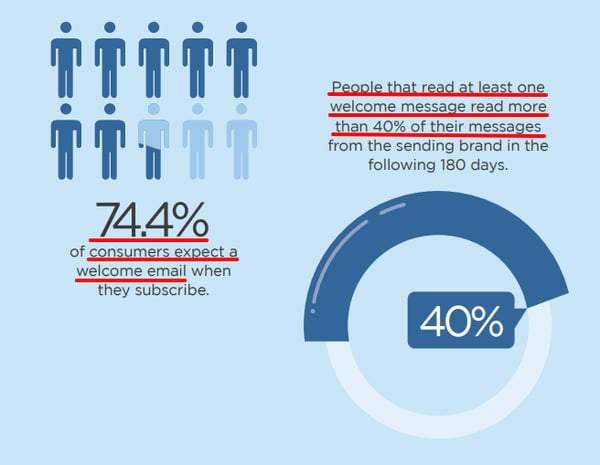
The goal of introductory emails is to turn new subscribers into potential customers without asking them to spend money. They're not ready for that. They want to get to know you and develop trust in your brand.
To nurture that relationship, give them something valuable they can use right away. Help them get one step closer to their goals by offering:
- Educational content including ebooks, email courses, and white papers that offer exclusive insight into your brand or how to accomplish something new. For instance, Upwork offers their The Fast Lane to Great Design ebook which is targeted to marketers looking for smart tips on how they can leverage freelancers for better design. Then, Upwork can convert their list into customers by promoting available contract designers, helping subscribers to not only learn ways to good designers but also helping to match them with the right resource.
- Actionable content like templates and workbooks that allow your subscribers to work through complex problems they're facing. At HubSpot, we've created an editorial calendar and template that content managers can download and customize for their own purposes. Beyond that, we also email them with additional content they might be interested in based on their company size and industry.
- Impactful newsletters that give subscribers a chance to learn new things on a regular basis. To capture recurring readers, the sleep blog eachnight uses a handy Sleep Calculator which reminds readers what their ideal bedtime is based on their required wake up time. If users opt in to having eachnight email them personalized results, they'll also get newsletter emails each time new sleep articles get published so you can learn more about how to achieve a restful night's sleep.
Stage 1 Email Example
Everyone loves examples, right? This one comes from Brendan Hufford at SEO For the Rest of Us. His welcome email is a real-world example of an impactful newsletter. Give it a read.
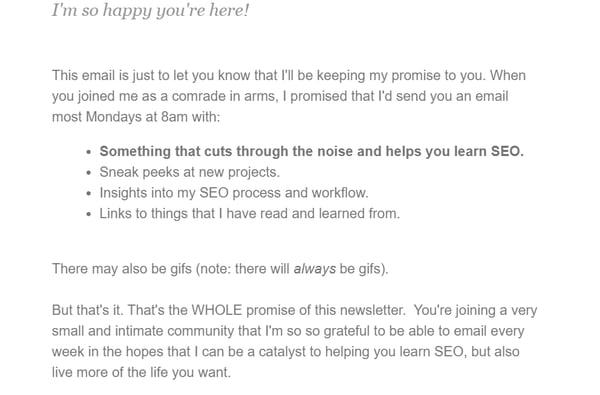
This email oozes with empathy, personality, humor, informative content, and promise of gifs. No product mentions or sales tactics for you to roll your eyes at.
This example works SO well because he outlines what you're going to get by joining his list. If you want to learn more about SEO, you know you're in the right place. Right away, you can tell if this is the newsletter for you.
Pro tip: Use customer personas with your emails to craft emails that are uber relevant to your target audience.
Stage 2: Consideration
Audience segmentation and email automation flow can help identify new potential customers who've made their way to the consideration stage. They're interested in your offer.
But they're not ready to click "buy now".
Nudging new subscribers towards your offer helps create buzz for your brand while delivering valuable content without shoving your product in their face. Which is exactly what should happen at this stage of the buyer's journey.
According to Jeremy Noronha, "The middle of the funnel also gives you an opportunity to understand your customers goals and interests. You can then leverage this to recommend suitable solutions for them to solve their problems."
After you identify potential customers and match them to one of your offers, you can start generating excitement around your product. These emails should introduce your offering and explain why they should care about it.
Valuable, educational content will help turn potential customers into qualified leads who are ready to buy something. You can do this using:
- Customer journeys like case studies and relevant testimonials.
- Hyper-relevant educational content by recording webinars, or product tutorials.
- High-level resources, knowledge base, and how-to guides.
At the end of each email, don't forget to include a clear call-to-action.
Stage 2 Email Example
Visme is a visual content tool for individuals, businesses, and enterprises. Their tools allow you to create presentations, infographics, social media graphics, and more.
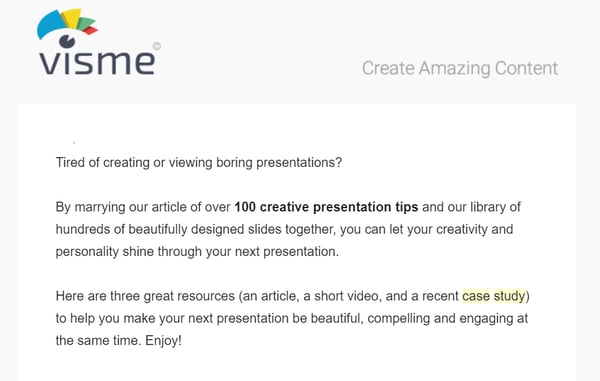
This email is great because it offers a high-level resource, a prerecorded tutorial, and a case study. Each one introduces the product and explains why you should care about creating visual content.
It works because you're not slapped in the face with another promotional email deserving of the delete button. It's short and punchy with a call-to-action to download the goods.
Stage 3: Decision
Qualified leads are ready to make a decision. They're weighing the pros and cons of buying your product (and other products, too). Since 59% of consumers say that marketing emails influence their buying decisions, these emails should be top-notch.
This is your chance to prove you have the solution to their problems. They should walk away wondering how they ever lived without you.
Your approach depends on your offer and the lead. But, all successful decision stage emails display an offer in a way that's relevant to the person receiving it.
When someone reaches this stage, you've already built a strong foundation for a long-term, beneficial relationship. They know who you are and they know what you have to offer.
These emails act as the last push someone needs to pull out their wallet. Get them excited, show them what they're missing, and always fall back on giving away valuable information for free.
Consider offering:
- Free trials, time-based offers, and discount codes
- Live Demos or Q&A Sessions: The GetVOIP's web-conferencing library is full of detailed reviews for different live conferencing tools. Use these to make an educated decision on which is right for your business.
- Proposals, estimates, or a free consultation
Stage 3 Email Example
Grammarly is a freemium online writing assistant. Everyone using the tool gets weekly usage statistics in their inbox.
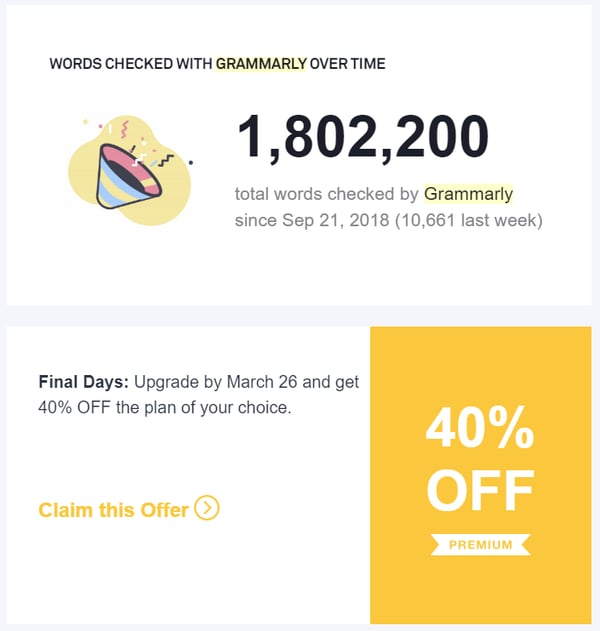
They use this as an opportunity to highlight their time-based premium offer. This email works because they present the offer surrounded by interesting stats about how you use their tool and the opportunities you're missing out on.
Many people enjoy seeing this information. Grammarly takes advantage of this by offering you a discount without coming across as scammy.
Stage 4: Advocacy
Customers are the life-blood of your business. When someone buys something, it's important to take a moment and celebrate the win. When you're done, think about how you're going to keep them around.
It costs 6-7 times more to gain new customers than it does to retain existing ones. So, turning previous customers into repeat customers and brand ambassadors should be at the top of your to-do list.
On average, 65% of business comes from existing customers. And 80% of businesses rely on email marketing to increase their retention rate. Giving away valuable and nurturing email content doesn't stop once a consumer becomes a customer. It actually becomes more important than ever.
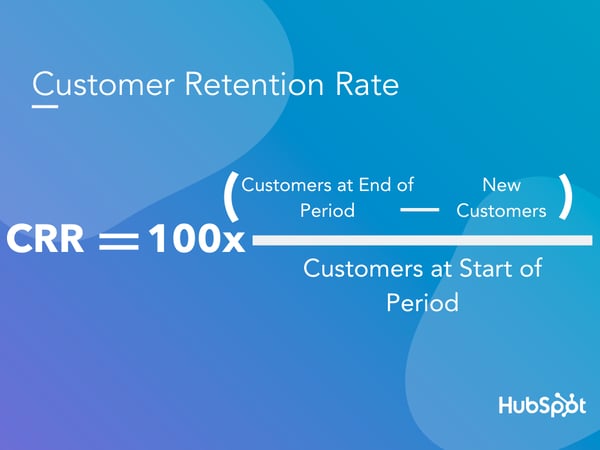
To help increase your customer retention rate, consider offering:
- Educational content, tutorials, and exclusive webinars that teach customers how to use your product to solve their biggest problems.
- Discount codes and offers that encourage customers to buy from you again.
- Personalized product recommendations and relevant cross/up-sell opportunities.
- Referral/loyalty programs that reward existing customers for spreading your message and attracting new customers.
- Consider integrating your emails with copywriting practices for better conversions.
- Create user personas to tailor emails to personal preferences of the target.
Additionally, customers are the only people who can give accurate and honest information on the flow of your business, your products, and your customer service efforts.
Because 88% of consumers trust testimonials as much as they trust their friends and family, displaying positive testimonials on your website can help you build trust with your audience.
So, use this opportunity to:
- Ask for an online review: 92% of consumers trust non-paid reviews over any other form of advertising. A few days after their purchase, ask for an honest review and make sure to reply to each one.
- Send out periodic product surveys: Use surveys to ask the right questions and gain valuable insight into your business and product offerings. Existing customers are the best source for this kind of information.
Stage 4 Email Example
Allbirds is a shoe manufacturer dedicated to carbon neutrality and environmentally friendly fashion. From responsibly sourced materials to mindful manufacturing, they hold themselves responsible for helping reduce environmental impact.
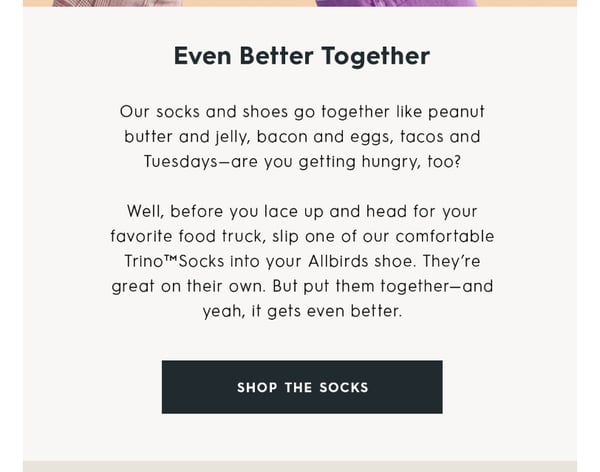
This email works because they showcase their fun and quirky message while suggesting the perfect pair of socks to go with your new pair of kicks. No gross sales tactics involved.
Writing the perfect email isn't easy. Especially when you consider the different stages of the buyer's journey. But, putting in the effort to do it right will work wonders for your business.
At HubSpot, our email marketing tool can help with this process. The tool gives you the power to brainstorm, write, automate, and send the perfect emails at the right time. You'll have automated and data-driven email campaigns running before you know it.
Take the time to test different campaigns and types of content with each segment of your audience. What works for one may not work for others. You can use the ideas listed here to create multiple campaigns to see what works for you.
from Marketing https://ift.tt/2yjYWCf
via
No comments:
Post a Comment